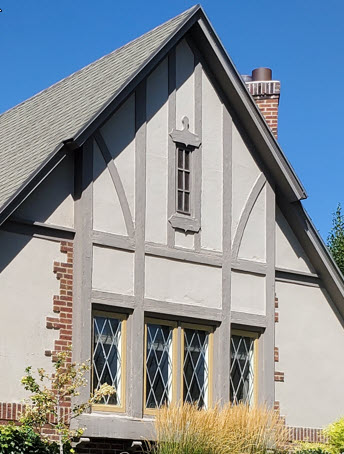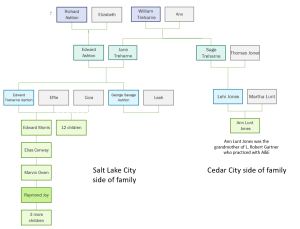
Raymond J. Ashton was born in Salt Lake City in the Utah Territory in 1887. Two factors in his early life influenced his development and success as an architect.
First, he was born into a well-known family of builders and real estate developers. His grandfather (George Ashton) was a cut-stone contractor; his father (Edward Tremaine Ashton) and uncle (George Savage Ashton) were partners in the contracting firms Ashton Brothers and Ashton Improvement Company. Between them, those firms were responsible for the construction of thousands of houses in Salt Lake City. Not only was Raymond J. Ashton an architect, but brothers Marvin O. was manager of the Rio Grande Lumber Company, and Edward M. was a principal in the realty firm Ashton-Jenkins.
Second was his connection to the Cedar City area. Raymond was born prior to Utah statehood to a devout LDS (Mormon) family. And, in fact, his father (Edward Treharne Ashton) was a polygamist. Raymond had 6 siblings who lived in Salt Lake City with their mother Effie; and 12 half-siblings by Edward Treharne Ashton’s second wife, Cora. Not long after Raymond was born Edward Treharne Ashton’s brother drove Cora and her children by wagon to Cedar City to avoid federal marshals whose objective was to jail polygamists. Cora and family stayed with Sage Treharne Jones, Raymond’s great-aunt, during their first trip Cedar City to hide in the ‘underground’ (The Edward Ashton). Many of Ashton & Evans’ first clients may have been developed through Raymond’s connections to this side of his family: the Lunts, the Jones, and many others.
EDUCATION, MISSION, FAMILY LIFE, AND ARCHITECTURAL PROMISE (1909 – 1915)
Raymond’s work ethic showed early. At ten he was a waterboy at his father’s construction sites and he delivered the Deseret News during high school. He graduated in Engineering from the University of Utah, walking 5 miles each direction every day (Vosbeck). During high school and university summers he worked at his family’s enterprises and as a draftsman (Architect Raymond). Soon after university graduation, he left on an LDS mission to the Netherlands, arriving in Liverpool by ship in October 1909. At that time, the Netherlands Mission also included Belgium. Family records show that Raymond may have served in Brussels, Liege, and Namur, Belgium (The Edward Ashton).
He was released from his mission in April 1912 and married Winnie Richards the next year in Salt Lake City where their first child (Yvonne) was born in 1915.
He completed several well-regarded residential works during this period, done in conjunction with his brothers’ real estate and construction firms.
- Booth Parsons Home, Salt Lake City, UT
- 1912, Raymond Ashton
- National Register of Historic Places
- George Albert Smith House, Salt Lake City, UT
- 1913, Raymond Ashton
- National Register of Historic Places
- Raymond Ashton is listed as the builder on the building permit. At that point, he was a manager at Ashton Improvement Company, his father’s construction firm (National Park Service, George Albert Smith house).
EARLY ARCHITECTURAL PROJECTS (1916 – 1922)
In 1916, Raymond and Winnie moved to Chicago where their second child (J.R.) was born. While in Chicago Raymond attended night school at Atelier Puckey (a member of the Society of Beaux-Arts Architects) and the Chicago Academy of Fine Arts (Architect Raymond; Architect returns, Vosbeck) and worked as a draftsman for several Chicago firms. The records are inconsistent, perhaps he did work with several of these top-tier architects: David Adler, Henry C. Dangler, Gardin & Martin, Dwight Perkins, and Richard Schmidt (Architect returns, Vosbeck).
When World War I halted nonessential building projects, Raymond joined the architectural department of Armour & Company designing corporate branch houses throughout the world and residential work for the Armour family (Architect returns). He clearly integrated himself into the architectural firmament of Chicago.
Only one architectural artifact remains from his Chicago period (Special collections).
Service building for A. Watson Armour residence, Lake Forest, IL
- 1917, RJA initials on blueprint
- Robert Work Architect, Successor to Henry C. Dargler Architects
Raymond returned to Salt Lake City in 1918 and entered into a partnership with Francis D. Rutherford, The partnership was dissolved in 1921 when Rutherford moved to California. Several artifacts remain from the Rutherford & Ashton partnership, including blueprints of the (Special collections):
- Millard County Courthouse, Fillmore, UT
- 1920, Rutherford & Ashton
- San Juan County Courthouse, Monticello, UT
- 1920, Rutherford & Ashton
Raymond Ashton then practiced alone through at least 1922, finishing up a few of his individual works while A&E got underway. His drawings during this period are beautiful and precisely inked (Building department; Special collections).
- Lafayette Elementary, Salt Lake City, UT
- 1923, Raymond J. Ashton
- Roosevelt Junior High addition, Salt Lake City. UT
- 1925, Raymond J. Ashton
Not only did these works establish his name in Utah, but also began relationships that would continue throughout his career.
ASHTON & EVANS (1922 - 1964)
The history, projects, and legacy of Ashton & Evans (A&E) are documented elsewhere on this site. On this page, I hope to describe Raymond’s role at A&E and in the larger architectural and civic communities.
Raymond’s role at A&E has been documented by several contemporaneous voices.
Raymond Evans’ daughters: “The partnership of Ashton and Evans was unique. Mr. Ashton was a very social type of person who did all the job seeking and obtaining. [Mr. Evans] on the other hand, was more than content to sit at the drafting table and carry out that end of the work. They worked remarkably well together” (Fiedler & Hilton).
Raymond J. Ashton, himself: “[These projects] are not alone my creations. We work as a team in this firm” (Raymond J. Ashton, 1956).
Raymond L. Evans: “When one calls at [our] office, [I] pretty nearly always inquire if [they] want to see “The Boss” (Architect Raymond).
The American Institute of Architects: “[Raymond’s] courageous belief that the profession has an obligation far transcending its material interest has encouraged your associates to work diligently and effectively toward the goal you set for them ….[Your] inherent modesty and outstanding ability to utilize the talents of your fellows had made your administration outstanding in its accomplishments” (Vosbeck).
And by my observation, if I was ever unclear about A&E’s role in a building design, I just needed to check the newspaper trail. Raymond – the social side of the A&E partnership – often spoke at building dedications!
Raymond served his profession and the community in many positions during his 50+ year career (Architect Raymond; Raymond Ashton, 1973).
- American Institute of Architects:
- National: Fellow (1940), Treasurer (1942), President (1943 – 1945)
- Utah Chapter: President (1930)
- American Architectural Foundation: Board President
- Chamber of Commerce:
- National: Chair, Construction Industry Advisory Council
- Salt Lake: Board of Governors
- Utah Building Congress: Founder
- Utah Symphony Orchestra: President
- Rotary Club (Salt Lake): President
In 1941, Raymond and Winnie moved from Salt Lake City to a country home in Kaysville, where he engaged in his favorite hobbies: raising purebred Arabian horses, cooking, and traveling (Kaysville couple; Raymond J. Ashton, 1956). Soon thereafter (1947), he began discussing his retirement. In 1952, he went on partial salary.
Ashton’s later life (1964 – 1973)
Raymond continued to serve as Senior Managing Principal at the firm through its changing leadership and names until full retirement – and a move to Prescott, AZ – in 1970. He passed away in Prescott in 1973.
RESEARCH NOTES
- Architect Raymond J. Ashton merits professional accolade. (1946, Nov 10). The Salt Lake Tribune. - https://newspapers.lib.utah.edu/ark:/87278/s6g7920h/29482952
- Architect returns home from the east. (1919, May 25). The Salt Lake Tribune. - https://newspapers.lib.utah.edu/ark:/87278/s60k3m1d/15025462
- Building Department (1938-1972). New Mission Home, 1917-1970 [Microfilm]. The Church of Jesus Christ of Latter-day Saints History Library.
- Fiedler, M.E. & Hilton, R.E. (1978, Jun). Raymond L. Evans personal history [Manuscript]. Copy in possession of Corrinne M. Fiedler.
- Kayville couple remodel old home on beautiful site. (1941, Nov 9). The Salt Lake Tribune. - https://newspapers.lib.utah.edu/ark:/87278/s648e3tf/30792774
- National Park Service (various dates). National Register of Historic Places Inventory Nomination Form: Yalecrest Historic District (2007); Booth Parsons Home (2012); George Albert Smith House (1993). United States Department of the Interior. - https://www.nps.gov/subjects/nationalregister/database-research.htm#table
- Raymond Ashton, 86, prominent as architect [Obituary]. (1973, Apr 10). The Arizona Republic.
- Raymond J. Ashton ... 'Each plays a part'. (1956, Nov 18). The Salt Lake Tribune. - https://newspapers.lib.utah.edu/ark:/87278/s60w3n0g/27650373
- Special Collections, Ashton & Evans collection [unprocessed blueprints]. J. Willard Marriott Library, The University of Utah.
- The Edward Ashton and Jane Treharne Ashton Legacy of Faith [Book]. (2005). The Edward and Jane Treharne Ashton Family Organization.
- Vosbeck, R.R. (2008). A legacy of leadership: The presidents of the American Institute of Architects 1857 -2007. The American Institute of Architects, Washington D.C. - https://content.aia.org/sites/default/files/2018-09/Presidents_Vosbeck_book.pdf









